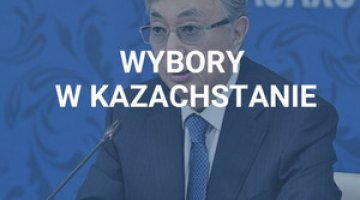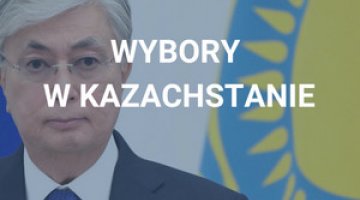Bloody clashes in western Kazakhstan
On 16 December in Zhanaozen (Mangystau region) riots broke out, and as a result of the pacification action at least ten people died. In the following days, demonstrations were also held at other places in the region. The situation has been stabilised as of now, thanks to the mobilisation of the institutions of force, the introduction of a state of emergency in the Zhanaozen area, and conciliatory gestures by the government towards the public. These events occurred on the twentieth anniversary of Kazakhstan’s independence and on the eve of parliamentary elections (15 January 2012); it seems likely that their political inspiration (or at least support for them in the media) came from the opposition in exile. The riots broke out against a background of strikes by oil company employees, which have been going on in the region since May; serious social tensions; and an overall increase in instability over the last six months in both western Kazakhstan and other parts of the country, associated with the activity of Islamic radicals (who had previously not been present in Kazakhstan).
The riots in western Kazakhstan are the most serious socio-political crisis in the state’s independent history. This crisis is breaking out against the background of two elements which are fundamental to the future of the country: the impending succession of power, and intense geopolitical manoeuvring (mainly between Russia and China) for influence in Central Asia.
Although the situation in western Kazakhstan has been temporarily stabilised, we must reckon with the possibility of socio-political tensions both on the domestic arena and in an international context in the future.
Tensions in Western Kazakhstan
Western Kazakhstan is geographically isolated from the rest of the country; the strategically important oil and gas industry is concentrated there. The region has seen mass internal migration, for reasons connected with both the economy and repatriation (the latter concerns the Oralmans, ethnic Kazakhs from outside the former Soviet republics, who together with their families number up to two million people). This has led to social tensions, from a relatively high crime level, up to the development of radical Islamic terrorist organisations. Since May, both in Zhanaozen and Aktau, unbroken strike action (which the government has ignored) for wages has been ongoing; the strikers have demanded compensation for harmful working conditions, and criticised the disparity in wages between Kazakhs and the mining companies’ foreign workers).
Riots broke out in Zhanaozen on 16 December, when a group of young people and some of the striking oilmen protesting since May began to destroy the stage which had been prepared for the Independence celebrations, and then burned the office of the UzenMunaiGaz gas company (a subsidiary of the state energy holding KazMunaiGaz), the magistrate’s office and several other buildings. During the riots, police forces responded with live ammunition, and a number of people died; estimates of the death toll range from 14 (official data) to several dozen. A day later in Shetpe, about 100 km away, a passenger train was halted and the engine burned in an act of solidarity with the protests in Zhanaozen; one person was killed as a result of clashes with the police. On 19 December in the region’s capital Aktau, in which strikes had also been held, there was a public protest against government brutality, which was attended by about two to three thousand people (an unprecedented number in Kazakhstan). Protests took place in Aktau on the following days, although these were less numerous and considerably less intense. The situation in the region was stabilised on 20 December and did not lead to any protests in other parts of the country (although it received wide coverage on the Internet, and among opposition groups and NGOs). In response to the riots in Zhanaozen, the government has introduced a two-week state of emergency there, and has established a committee to look into the riots and their background, and has thus avoided the further escalation of tensions.
There are some doubts concerning the nature of the riots in Zhanaozen. The previous strikes and protests in the area were organised by non-registered trade unions, and were also supported by opposition groups associated with the exiled oligarch, Mukhtar Abliyazov (including programmes on the K+ TV station, which broadcasts from Russia and is associated with him, as well as articles in the Respublika newspaper). The riots of 16 December were provoked by a group of young people who were joined by some of the original protesters; the possibility of external provocation cannot be ruled out. Despite the lack of strictly political slogans, the symbolic date of the riots (the national holiday, the anniversary of the bloody suppression of protests by the KGB in Almaty in 1986) gives them a political character, one which is decidedly unfavourable to the government. The bloody put-down of the riots has unleashed wider social discontent – aimed directly against the government.
Consequences
Despite the regional nature of the disturbances, and the authorities’ current control of the situation, the recent events in the Mangystau region pose a very serious challenge for the government. The suppression of the riots by force has allowed the government to temporarily stave off the threat of an escalation of instability, but this has in no way solved the problems that lie at the root of the tension, and have in fact raised the level of public discontent. If the government limits itself to the use of force, we may expect further outbreaks of discontent. The riots have revealed the depth of the internal tensions in Kazakhstan: the social background (despite the country’s relative prosperity), but also a sense of the alienation and arrogance of the governing elites. The events in Western Kazakhstan have also struck at the unwritten social contract which is one of the pillars of the authoritarian political system, and thus indirectly at the personal authority of President Nursultan Nazarbayev. Social consent to this system has been based on the internal stability and economic development which he has guaranteed.
In Kazakhstan there is currently no political alternative to the ruling camp, nor are there conditions to establish such a force. Tensions are inherent in the fundamental challenge facing Kazakhstan today of the succession of power; President Nursultan Nazarbayev is 71 years of age, and moves towards the emergence of a successor to him have long been playing out. The early, centrally-controlled parliamentary elections scheduled for 15 January 2012 are an indirect part of this process, but its success is by no means guaranteed. The current crisis has also increased the room for manoeuvre of those oligarchs resident abroad who have lately sharply criticised the government (especially Mukhtar Abliyazov), and weakened the position of the favourite for the succession, Timur Kulibayev. He is the President’s son-in-law, and his control extends to the key energy sector, including those companies where the strikes have taken place.
This crisis has complicated the international position of Kazakhstan, which from the political and economic points of view is a key state in the region, and of fundamental importance in the regional strategic calculations of Russia (the region’s traditional great power), China (whose significance and presence in Central Asia is growing rapidly), and the USA. The succession of power will raise the geopolitical stakes. Kazakhstan's internal problems will be exacerbated above all by Russia, which has the strongest instruments for influencing events in this country (including close contacts with the ruling elite; its influence on the opposition abroad; and on Kazakhstan’s information space, including the pro-opposition K+ and Respublika, which are both hosted in Russia). The Russian media and internet are already using the problems in Kazakhstan to discredit their geopolitical rivals; they have attributed the riots to the US as an attempt to carry out a ‘Libyan scenario’ in Central Asia, and have emphasised the anti-Chinese elements of the strikes in Kazakhstan (a Chinese company is co-owner of one of the oil companies in Aktau).




